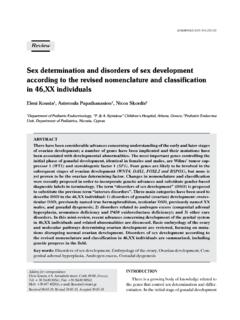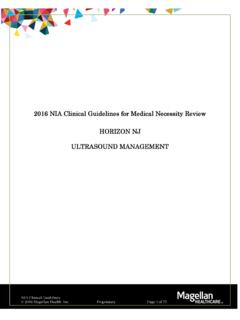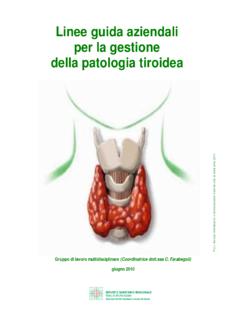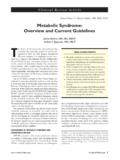Transcription of Subclinical Cushing’s syndrome: Current concepts …
1 HORMONES 2014, 13(3):323-337. Review Subclinical cushing 's syndrome : Current concepts and trends George N. Zografos,1 Iraklis Perysinakis,1 Evangeline Vassilatou2. 3 Department of Surgery, General Hospital G. Gennimatas ; 2 Endocrine Unit, 2nd Department of Internal Medicine, 1 rd Attikon University Hospital, Athens, Greece Abstract Clinically inapparent adrenal masses which are incidentally detected have become a common problem in everyday practice. Approximately 5-20% of adrenal incidentalomas present subclini- cal cortisol hypersecretion which is characterized by subtle alterations of the hypothalamic- pituitary-adrenal axis due to adrenal autonomy.
2 This disorder has been described as Subclinical cushing 's syndrome , since there is no typical clinical phenotype. The diagnosis of Subclinical cushing 's syndrome is based on biochemical evaluation; however, there is still no consensus for the biochemical diagnostic criteria. An abnormal 1mg dexamethasone suppression test (DST) as initial screening test in combination with at least one other abnormal test of the hypothalamic-pituitary-adrenal axis has been advocated by most experts for the diagnosis of Subclinical cushing 's syndrome . DST is the main method of establishing the diagnosis, while there is inhomogeneity of the information that other tests provide.
3 Arterial hypertension, diabetes mellitus type 2 or impaired glucose tolerance, central obesity, osteoporosis/vertebral fractures and dyslipidemia are considered as detrimental effects of chronic subtle cortisol excess, although there is no proven causal relationship between Subclinical cortisol hyperse- cretion and these morbidities. Therapeutic strategies include careful observation along with medical treatment of morbidities potentially related to subtle cortisol hypersecretion versus laparoscopic adrenalectomy. The optimal management of patients with Subclinical cushing 's syndrome is not yet defined.
4 The conservative approach is appropriate for the majority of these patients; however, the duration of follow-up and the frequency of periodical evaluation still remain open issues. Surgical resection may be beneficial for patients with hypertension, diabetes mellitus type 2 or abnormal glucose tolerance and obesity. Key words: Adrenal incidentaloma, Clinical implications, Diagnosis, Laparoscopic adrenalectomy, Subclinical cushing 's syndrome , Treatment INTRODUCTION common tumors in humans, as described in autopsy Masses of the adrenal glands are one of the most ,2 The first report of adrenal masses revealed by computed tomography in patients with unsuspected Address for correspondence: George N.
5 Zografos, MD, 10 K. Ourani Str., 152 37 Athens, adrenal disease was published by Korobkin et al. in Greece, Tel.: +30 6944 918944, Fax: +30 210 7706915, Since then, progress in imaging modalities E-mail: and ever more widespread use of imaging studies Received: 26-01-2014, Accepted: 18-06-2014 have led to increasing detection of these lesions in a 324 Zografos ET AL. clinical setting due to imaging evaluation performed indicating the presence of a hyperfunctioning adrenal for reasons unrelated to adrenal disease. Therefore, adenoma, without clinical or biochemical evidence of clinically inapparent adrenal masses, called adrenal cushing 's syndrome .
6 These findings were considered incidentalomas, have become a common problem in similar to thyroid hot nodules revealed by thyroid scan everyday It must be mentioned that adrenal in the absence of Further in vivo8-10. masses discovered during staging procedure in patients and in vitro studies11,12 documented the presence of with malignancy are not considered as incidentally Subclinical cortisol hypersecretion in patients with detected. Thus, the definition of adrenal incidentaloma adrenal incidentalomas, and the terms pre- cushing 's excludes patients with overt adrenal hyperfunction syndrome 13 and preclinical cushing 's syndrome and patients undergoing imaging evaluation as part were introduced for its ,14 However, of staging procedure for , 5 because preclinical cushing 's syndrome implies possible progression to overt cushing 's syndrome , Initial diagnostic evaluation of a patient with an ad- which was shown to happen rarely,15-17 the terms SCS.
7 Renal incidentaloma aims to determine the functional and Subclinical autonomous cortisol hypersecretion18. status of the mass and the possibility of malignant have been proposed in order to define this hormonal disease. The vast majority of these lesions are benign abnormality more adequately, with the former be- nonhypersecreting cortical neoplasms. However, a ing widely used in the literature. Since 1990, a large significant percentage of cases present Subclinical number of studies have shown that Subclinical cortisol hormonal activity, mainly concerning glucocorticoid hypersecretion results in various abnormalities of the Subtle cortisol hypersecretion by adrenal HPA axis, revealed by detailed hormonal evaluation, incidentalomas is characterized by alterations of the at an average range of 5-25% of patients with adrenal hypothalamic-pituitary-adrenal (HPA)
8 Axis due to ,14,19 This wide range of prevalence adrenal autonomy in the absence of the typical clini- of SCS is mostly due to the use of different diagnostic cal phenotype of hypercortisolism, a disorder that criteria in relevant studies, in addition to different has been defined as Subclinical cushing 's syndrome investigational protocols and series' size as well as (SCS).5 Therefore, the diagnosis of this disorder is referral bias. Therefore, SCS is a common disorder entirely dependent on laboratory evaluation. Because given that the prevalence of adrenal incidentalomas the optimal diagnostic approach is still debated, in the general population is estimated at between the prevalence of SCS has not been , based on autopsy studies.
9 SCS prevalence Moreover, the variation of biochemical diagnostic increases with age, with a peak in the eighth decade criteria applied in relevant studies has resulted in of Subclinical cortisol hypersecretion may be limitations concerning the assessment of the clinical intermittent in some patients, as shown in follow-up significance of subtle cortisol hypersecretion. Thus, studies,17,21-23 and seems to be related to mass the optimal management of patients with adrenal Moreover, follow-up studies15,24,25 have shown that adenomas and SCS is not yet Choices larger adrenal incidentalomas (mass size > cm are either close follow-up combined with medical according to the most recent study26) have a higher treatment of potentially associated morbidities with risk of developing SCS.
10 The possibility of an increased subtle cortisol hypersecretion or surgical treatment. frequency of SCS in patients with bilateral adrenal In this review we will focus on the diagnostic criteria incidentalomas has been examined; however, existing and clinical implications of SCS as well as surgical data are ,26-28. treatment of these patients. DIAGNOSIS OF Subclinical cushing 'S. OVERVIEW syndrome . Subclinical cortisol hypersecretion by adrenal The diagnosis of SCS is based on biochemical incidentalomas was first described by Beierwaltes et Several tests assessing the hypothalamic- al. in 1974.









